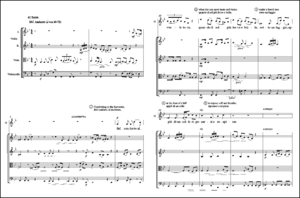Intonalism
Intonalism is an approach to musical structure in which harmonic areas[clarification needed] move according to a complete universe based on just intonation. Each tonal area is tuned to all other tonal areas by means of pure intervals.[clarification needed]
Copper-intonalism
Intonalism was developed by William Copper over the period from 2009 - 2016; during this development then-active members of the various Facebook xen harmony pages contributed ideas and suggestions. In Copper's usage, all tonal areas relate to each other using 5-limit just intonation but there is no reason that more extended tonal relations could not be based on higher limit pure intervals.
To distinguish this form of intonalism from the other, you could call it Copper-intonalism.[idiosyncratic term]
If somebody just says “intonalism” without context, they usually mean William Copper’s version.
Notation

This example of the score and notations illustrates several things. The key signature includes a reference notation to indicate where the tonal center is tuned; individual notes are adjusted up or down by syntonic comma as needed; and the final bar illustrated shows one of the many tonal areas found through intonalism but impossible in equal temperament, even beginning from the same reference pitch, in this case A=440.
Neely-intonalism
In 2020, music educator Adam Neely picked up the term and used it in his Seven Levels of Jazz Harmony, with a somewhat different and rather ambiguous intent, where he seemed to describe the use of a tempered scale (often 12edo) for the lead melody of a piece. The current melody note at any given point in time is then treated as a reference pitch, and the current backing chord uses pure just intonation, tuned relative to the current reference pitch. In a sense this is an inverse form of adaptive just intonation where the bass line adjusts to a tempered scale and the melody and harmony notes tune to it.
To distinguish this form of intonalism from the other, you could call it Neely-intonalism.[idiosyncratic term]
Fluid just intonation
Main article: Fluid just intonation
In 2021, composer and music theorist Rosie Sheldon modified Neely-intonalism to create fluid just intonation, which replaces the 12edo skeleton with a pure JI skeleton.